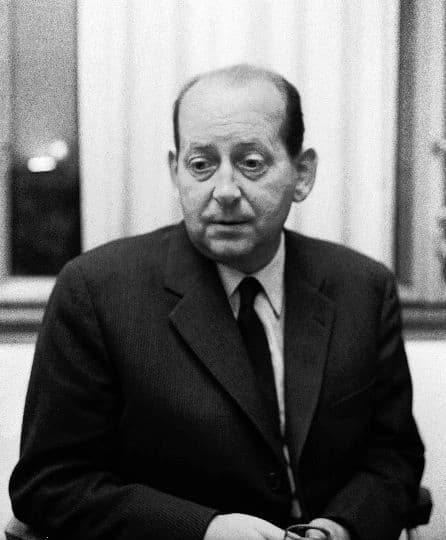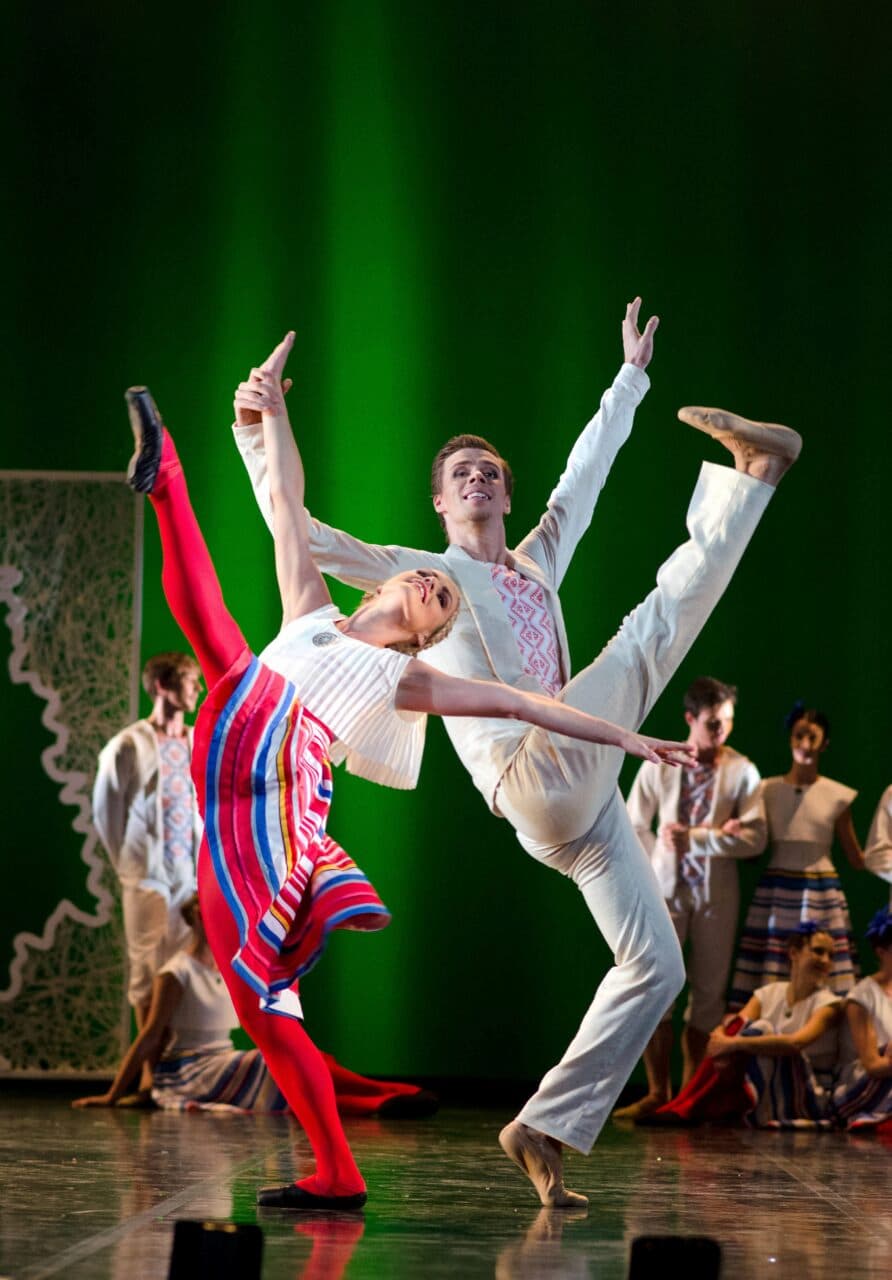When I was writing my blog on the Estonian composer Eduard Tubin, I came across a quote that reads, “Eduard Tubin is to Estonia what Jean Sibelius is to Finland.” This struck me as a very insightful statement. Both composers wrote symphonies that were celebrated in the world’s concert halls, and both established a national identity in music by relying on local folktales.

Eduard Tubin
The Estonian folktale that caught Tubin’s attention is called Kratt, loosely translated as “goblin.” Basically, it is like a golem that has to do whatever you want it to do. The monster is made of hay or other farm implements and brought to life by giving the Devil three drops of blood to buy a soul for the Kratt. The monster would then steal gold and money to gain riches for his Master.
Eduard Tubin: Kratt (Excerpts)
When Tubin worked as a conductor in a theatre in Tartu in the 1930s, he wrote stage music for several plays. When the Estonia theatre in Tallinn announced a contest for a stage work, Tubin set to work on the ballet pantomime Kratt in one act. The idea of writing the work originated during a visit to Budapest when he showed his First and Second Symphonies to Zoltán Kodály. It was Kodály who advised him to turn his attention to the use of folk materials in his music.
Once Tubin returned to Estonia, he contacted the head of the Estonian Folklore Archive to help him find stories about goblins. Tubin searched through the archives at length and got help from the ballet dancer Elfriede Saarik, his future wife. The eventual plot for Kratt devised by Saarik is a fusion of elements from several folktales, but essentially, a greedy farmer is advised by a wizard to manufacture a treasure-finding goblin, Kratt.
Eduard Tubin: Kratt (Goblin) Act 1 – “The Creating of Kratt” (Iris Oja, mezzo-soprano; Female Choir of the Estonian Philharmonia Chamber Choir; Estonian National Symphony Orhcestra; Arvo Volmer, cond.)
Act 1 “The Creation of Kratt”

Eduard Tubin’s Kratt
The music beautifully follows the story, and after a brief introduction to Act 1, we are introduced to the greedy farmer dancing like a bird around a bonfire to attract fertility spirits. A wizard is passing by and advises him to stop dancing for a good harvest and make a Kratt instead. To persuade the farmer, the wizard conjures up visions of gold, silver and precious stones that the Kratt would bring him.
The farmer is delighted and, together with the wizard, makes Kratt’s body. After the work is completed, the farmer goes to the crossroads and calls the Devil’s name four times. The Devil finally appears and takes three drops of blood from the Farmer’s forefinger, bringing Kratt to life. As the monster comes to life, it attacks the farmer and hits him on the head to give his soul at once to the Devil. However, the wizard already understood what was coming and had put an iron kettle on the farmer’s head to protect him.
Act 2 “Kratt’s Work”
Harvest is in full swing, and the farmworkers return from the field for the evening meal at the farmer’s house. His daughter is setting the table, and a farmhand is trying to help her. The farmer gets angry at the poor boy for trying to flirt with his daughter, and he sends him away angrily. The farmer, meanwhile, is heading for the granary to feed Kratt. The cheerful harvesters again return, and the farmhand puts a wreath on the girl’s head. The farmer again notices the farmhand dancing around his daughter and tells him angrily to go away.
Once everybody is gone, the farmer orders Kratt to bring him more riches, and the monster soon returns with various treasures. As the Northern Lights are streaming across the sky, people who have sold their souls to the Devil gather for a feast. With the help of Kratt, the farmer joins the feasting Satanists, but he is secretly observed by the farmhand. Kratt becomes aware of the secret observer, and in a panic, the farmhand strikes Kratt with an axe. The wounded Kratt now attacks him, but the farmer steps in and turns his axe towards Kratt, cutting off his legs. With Kratt being rendered powerless, the farmhand manages to flee.
Act 3 “Night Herdsmen”

Eduard Tubin’s Kratt
The village maidens come to sing and dance with the herdsmen. The farmhand and the girl meet again and are happily drawing away from the others. When a strange light appears, the farmhand know that it is Kratt coming from a treasure hunt. With his knife, the boy draws three magical circles on the ground, and Kratt is forced to land in the middle.
The herdsmen are teasing Kratt, who gets more and more enraged. However, he cannot escape from the herdsmen, and he finally tricks the boy to take the knife out of the ground to break the magic circle. Kratt, fully enraged and bent on vengeance flies away swearing to settle his score with the farmer.
Act 4 “Satanists”
The Satanists, including the Farmer, are feasting when he notices that his farmhouse is ablaze. He rushes toward his house but is attacked by Kratt, who, after setting the farmhouse on fire, has come to fetch the farmer’s soul. The farmer tries to bully Kratt into obedience, but Kratt is undeterred and strangles the farmer. When the herdsmen are rushing to the scene, they recognise the dead body of the greedy farmer.
Eduard Tubin: Kratt (Goblin) Act 2: “Kratt’s Work” (Iris Oja, mezzo-soprano; Female Choir of the Estonian Philharmonic Chamber Choir; Estonian National Symphony Orchestra; Arvo Volmer, cond.)
The Competition
Tubin did not find any direct folk tunes dealing with goblins, but he did write down roughly 30 folk tunes in the library. He later used the tunes for his ballet music and proudly commented, “Kratt is completely based on folk music, which is our nearly inexhaustible treasure.” It turned out to be the first ballet in the history of Estonian music, but it did not win a prize. The jury found that it did not conform to the rules of the contest.
Tubin recalled, “My ballet was the only one in the contest, but they found that it was too short, it didn’t fill the evening. My Kratt was in four scenes and lasted a lot more than an hour.” The actual reason was probably not the ballet’s brevity but the musical language. For some members, it was considered too modern.
Tubin was still hoping to see his Kratt on stage, but the Soviet Union’s occupation of Estonia in June 1940 canceled everything. However, the composer was quickly asked to rework the ballet and add some music. The new version was completed in 1941, the same year he married Elfriede Saarik. It finally reached the stage of the Estonian theatre on 24 February 1944.
Eduard Tubin: Kratt (Goblin) Act 3: “Night Herdsmen” (Iris Oja, mezzo-soprano; Female Choir of the Estonian Philharmonic Chamber Choir; Estonian National Symphony Orchestra; Arvo Volmer, cond.)
Three Versions and a Suite

Eduard Tubin’s Kratt
But that’s not all of the story. Kratt was performed six times before a bombing raid by Soviet forces destroyed the theatre and all the scores. The entire theatre went up in flames from the bombing, and audiences and all the dancers in their costumes ran out of the burning building. The actor playing the part of the Devil also ran across the street to the air-raid shelter, but people thought that they saw the real devil and started praying and crying.
The fire destroyed the only complete score of Kratt, and only a set of instrumental parts survived. Tubin took these parts with him when he fled to Sweden in 1944 with his family. Only in 1959 did the Estonia theatre ask if it would be possible to stage Kratt once more. Tubin decided to restore the score from the instrumental parts. He writes, “to restore the score after the instrumental parts is maybe the most boring trial of patience that I know of so far. I did it in about one year, at the same time, polishing some details and nuances, pulling together parts which were falling apart and so on.”
The third version of Kratt was performed on 10 June 1961 on the occasion of Tubin’s visit to Estonia. The ballet was a great success and ran for 56 performances. It even made it to Leningrad in 1965. A critic writes, “Tubin is one of the great masters of our time. The music, which is influenced by Stravinsky, Bartók and de Falla, is colourful, rhythmically vital, skilfully orchestrated, suggestive and full of contrasts.
In 1961, Tubin composed his Suite from the ballet Kratt, commissioned by the Swedish Radio Symphony Orchestra. The composer extracted colourful imagery from his ballet music, always combining folk music with modern means of expression. Kratt, the folktale, has also inspired some modern interpretations in the medium of film. Many movies need a happy ending, so how do you actually get rid of the Kratt? One answer comes from Estonian folklore itself, and it tells Kratt to build a ladder out of bread, which would cause the creature to catch fire and destroy itself.
For more of the best in classical music, sign up for our E-Newsletter
Eduard Tubin: Kratt (Goblin) Act 4: “Satanists” (Iris Oja, mezzo-soprano; Female Choir of the Estonian Philharmonic Chamber Choir; Estonian National Symphony Orchestra; Arvo Volmer, cond.)


